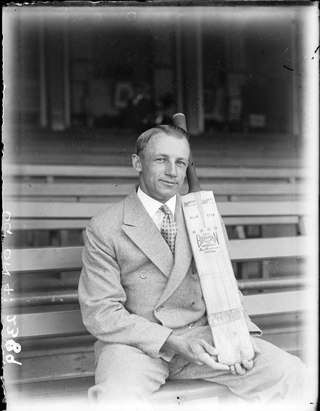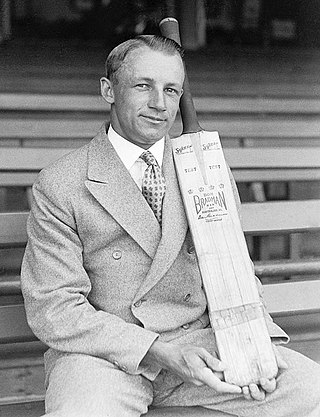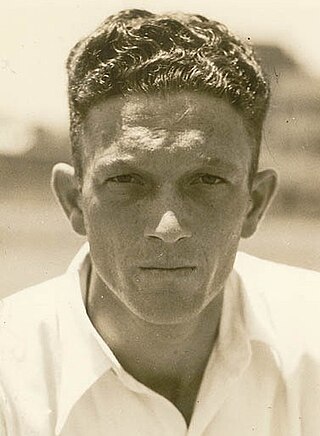Related Research Articles

William Arras Johnston was an Australian cricketer who played in forty Test matches from 1947 to 1955. A left arm pace bowler, as well as a left arm orthodox spinner, Johnston was best known as a spearhead of Don Bradman's undefeated 1948 touring team, well known as "The Invincibles". Johnston headed the wicket-taking lists in both Test and first-class matches on the tour, and was the last Australian to take over 100 wickets on a tour of England. In recognition of his performances, he was named by Wisden as one of its Cricketers of the Year in 1949. The publication stated that "no Australian made a greater personal contribution to the playing success of the 1948 side". Regarded by Bradman as Australia's greatest-ever left-arm bowler, Johnston was noted for his endurance in bowling pace with the new ball and spin when the ball had worn. He became the fastest bowler to reach 100 Test wickets in 1951–52, at the time averaging less than nineteen with the ball. By the end of the season, he had played 24 Tests and contributed 111 wickets. Australia won nineteen and lost only two of these Tests. In 1953, a knee injury forced him to remodel his bowling action, and he became less effective before retiring after aggravating the injury in 1955. In retirement, he worked in sales and marketing, and later ran his own businesses. He had two sons, one of whom became a cricket administrator. Johnston died at the age of 85 on 25 May 2007.

The Australian cricket team in England in 1948 is famous for being the only Test match side to play an entire tour of England without losing a match. This feat earned them the nickname of "The Invincibles", and they are regarded as one of the greatest cricket teams of all time. According to the Australian federal government, the team "is one of Australia's most cherished sporting legends". The team was captained by Don Bradman, who was making his fourth and final tour of England.

The Australian cricket team toured England in the 1953 season to play a five-match Test series against England for The Ashes.

The 1948 Ashes series was that year's edition of the long-standing cricket rivalry between England and Australia. Starting on 10 June 1948, England and Australia played five Tests. Australia had not lost a Test since the Second World War and were strong favourites. Their captain Don Bradman had publicly expressed his ambition of going through the tour without defeat, and Australia won 10 of their 12 lead-up matches, eight by an innings. The England team, however, had several notable players themselves, including Len Hutton, Denis Compton and Alec Bedser. Nevertheless, the final result was a 4–0 series win for Australia, with the Third Test being drawn. They thus retained The Ashes. The Australians remained undefeated for their entire tour of England, earning them the sobriquet of The Invincibles.

Keith Miller was a member of Donald Bradman's famous Australian cricket team, which toured England in 1948 and went undefeated in its 34 matches. This unprecedented feat by a Test side touring England earned the Australians the sobriquet "The Invincibles". Miller was an all-rounder: a right-arm opening fast bowler and a right-handed middle-order batsman. With Ray Lindwall, he formed Australia's first-choice opening attack, a combination regarded as one of the best of all time. Miller was also a skillful slip fielder, regarded by his captain as the best in the world.

During the 1946–47 Australian cricket season, all rounder Keith Miller represented Victoria and Australia. A 27-year-old right-handed batsman and fast bowler, Miller played in all five Tests against England, performing well with both bat and ball. He finished top of the Australian Test bowling averages, taking 16 wickets at 20.88, and was second in the batting averages, scoring 384 runs at 76.80. On his Ashes debut in the First Test in Brisbane, Miller scored 79 before taking match bowling figures of 9 wickets for 77 runs (9/77) in Australia's innings victory. In the Fourth Test, played at the Adelaide Oval, Miller broke through for his first Test century, scoring an unbeaten 141. A middle-order batsman and right-arm opening bowler, Miller finished the Test series as Australia's joint leading wicket-taker, along with his new ball partner Ray Lindwall, as Australia won the series 3–0.

The Fifth Test of the 1948 Ashes series, held at The Oval in London, was the final Test in that cricket series between Australia and England. The match took place on 14–18 August, with a rest day on 15 August. Australia won the match by an innings and 149 runs to complete a 4–0 series win. It was the last Test in the career of Australian captain Donald Bradman, generally regarded as the best batsman in the history of the sport. Going into the match, if Australia batted only once, Bradman needed only four runs from his final innings to have a Test batting average of exactly 100, but he failed to score, bowled second ball for a duck by leg spinner Eric Hollies.
Ray Lindwall was a key member of Donald Bradman's famous Australian cricket team, which toured England in 1948. The Australians went undefeated in their 34 matches; this unprecedented feat by a Test side touring England earned them the sobriquet The Invincibles.
Bill Johnston was a key member of Donald Bradman's famous Australian cricket team, which toured England in 1948. The Australians went undefeated in their 34 matches during the English summer; this unprecedented feat by a Test side touring England earned them the sobriquet The Invincibles.

Don Tallon was a key member of Donald Bradman's famous Australian cricket team tour of England in 1948, in which Australia was undefeated in their 34 matches. This unprecedented feat by a Test side touring England earned them the sobriquet The Invincibles.

Ernie Toshack was a member of Donald Bradman's famous Australian cricket team, which toured England in 1948 and was undefeated in their 34 matches. This unprecedented feat by a Test side touring England earned Bradman's men the sobriquet The Invincibles.

The Fourth Test of the 1948 Ashes series was one of five Tests in a cricket series between Australia and England. The match was played at Headingley Cricket Ground at Leeds from 22 to 27 July with a rest day on 25 July. Australia won the match by seven wickets to take an unassailable 3–0 series lead. In successfully chasing a target of 404, they set a new world record for the highest victorious runchase in Test history, a record lasting until 1976.
The Third Test of the 1948 Ashes series was one of five Tests in the Ashes cricket series between Australia and England. The match was played at Old Trafford in Manchester from 8–13 July 1948, with a rest day on 11 July. The match was drawn after the whole of the fourth day and the first half of the fifth day was washed out due to rain; England had the upper hand before the weather intervened. The draw maintained Australia's 2–0 lead in the series, which was established through victories in the first two Tests. As Australia were the holders of The Ashes, the draw meant that England could do no better than level the series 2–2 by winning the last two Tests, and thus Australia retained The Ashes.
The Second Test of the 1948 Ashes series was one of five Tests in the Ashes cricket series between Australia and England. The match was played at Lord's in London from 24 to 29 June, with a rest day on 27 June 1948. Australia won the match by 409 runs to take a 2–0 lead, meaning that England would need to win the remaining three matches to regain The Ashes.

The First Test of the 1948 Ashes series was one of five Tests in the Ashes cricket series between Australia and England. The match was played at Trent Bridge in Nottingham from 10 to 15 June with a rest day on 13 June 1948. Australia won the match by eight wickets to take a 1–0 series lead.

Don Bradman toured England in 1948 with an Australian cricket team that went undefeated in their 34 tour matches, including the five Ashes Tests. Bradman was the captain, one of three selectors, and overall a dominant figure of what was regarded as one of the finest teams of all time, earning the sobriquet The Invincibles.
Lindsay Hassett was the vice-captain and one of three on-tour selectors for Don Bradman's famous Australian cricket team, which toured England in 1948. The Australians went undefeated in their 34 matches; this unprecedented feat by a Test side touring England earned them the sobriquet The Invincibles, and resulted in them being regarded as one of the greatest teams of all time. A right-handed batsman, Hassett played in all five Tests; he was a middle-order batsman in all but the Fourth Test, when he stood in as an opener due to an injury to Sid Barnes.

Ian Johnson was a member of Donald Bradman's famous Australian cricket team, which toured England in 1948. Bradman's men went undefeated in their 34 matches; this unprecedented feat by a Test side touring England earned them the sobriquet The Invincibles.

Sam Loxton was a member of Donald Bradman's famous Australian cricket team, which toured England in 1948. Bradman's men went undefeated in their 34 matches; this unprecedented feat by a Test side touring England earned them the sobriquet The Invincibles.

The 1946–47 Ashes series consisted of five cricket Test matches, each of six days with five hours play each day and eight ball overs. Unlike pre-war Tests in Australia, matches were not timeless and played to a finish. It formed part of the MCC tour of Australia in 1946–47 and England played its matches outside the Tests in the name of the Marylebone Cricket Club. The England team was led by the veteran Wally Hammond and his vice-captain Norman Yardley with the strong batting line up of Len Hutton, Cyril Washbrook, Bill Edrich, Denis Compton and Joe Hardstaff, but a weak bowling attack that relied on pre-war bowlers like the 37-year-old Bill Voce of Bodyline fame and the mercurial leg-spinner Doug Wright. The two successes of the tour were the newly capped Alec Bedser, who would carry the England bowling attack until 1955, and Godfrey Evans who would be England's first choice wicketkeeper until 1959. England had drawn the Victory Tests 2–2 in 1945 and were thought to be equal in strength, but Hammond lost 3–0 to Don Bradman's Australian team which had only two other pre-war players – Lindsay Hassett and Sid Barnes, who had played 5 Tests between them – and was packed with fresh talent in the shape of Arthur Morris, Keith Miller, Ray Lindwall, Colin McCool, Ernie Toshack and Don Tallon. There were several controversial umpiring decisions which assumed greater significance as they favoured Australia and in particular Don Bradman.